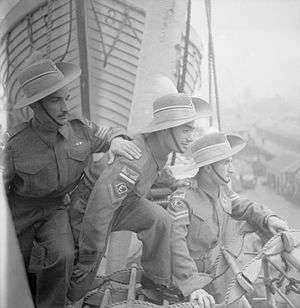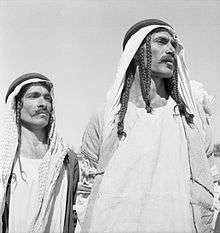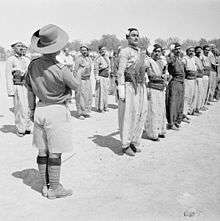Iraq Levies
The Iraq Levies (also known as the Assyrian Levies as they would eventually become dominated by ethnic Assyrians) was the first Iraqi military force established by the British in British controlled Iraq.[1] The Iraq Levies originated in a local Arab armed scout force raised during the First World War. After Iraq became a British Mandate, the force became a minority manned force of mostly Assyrians, Kurds and Iraqi Turkmen who lived in the north of the country while the nascent Iraqi Army was manned by Arabs. Eventually it became a mostly Assyrian manned and British officered force while it was used mostly for the guarding of the Royal Air Force bases in Iraq.[2]
| Iraq Levies | |
|---|---|
 Three members of the RAF Levies arrive at Liverpool aboard SS Orbita in 1946. | |
| Active | 1921–1955 |
| Country | Iraq |
| Allegiance | United Kingdom |
| Branch | British Army Royal Air Force |
| Engagements | World War II • Anglo-Iraqi War |
The Levies distinguished themselves in May 1941 during the Anglo-Iraqi War and were also used in other theatres of the Second World War after 1942. The force thereafter grew and survived until it was disbanded in May 1955 when control of RAF Habbaniya and RAF Shaibah was handed to Iraq.[3]
History
The Iraq Levies traced their history to the Arab Scouts organized in 1915 by Major J. I. Eadie, of the British Indian Army who served as a Special Service Officer in the Muntafiq Division in Mesopotamia. He recruited forty mounted Arabs from the tribes round Nasiriyeh, for duty under the Intelligence Department as bodyguard for political officers in southern and central Iraq. By 1918 the Arab Scouts increased to 5,467 Arabs, Kurds, Turkoman, Marsh Arab and Assyrian militia.[2][4]
Organisation
In 1919 the force changed names twice, first to the Militia and then in July to the Iraq Levies when Iraq became a British Mandate. On 12 August 1919, the force became known as the "Arab and Kurdish Levies."[2] Also in 1919 the Iraq Levies were split into a strike force of 3,075 men, based in Baquba, and district Police force of 1,786 men.[4] On 1 August 1919, the Levy and Gendarmerie Orders were published in which the control of the Levies, and the duties of the Inspecting Officer of the Levies, who were limited to inspection and administration, were defined. This put the Levies were under the control of three different people: the Inspecting Officer, the Political Officer of the Area, and the Local Administrative Commandant. The budget was dealt with by the Inspecting Officer, except in the Northern Iraqi Provinces of Kirkuk, Sulaimani and Mosul Liwas, where Political Officers dealt with it.[2] Later the Levies came under their own OC Iraq Levies.
The Levies consisted of a Headquarters (first located in Baquba, then Hinaidi, and then in Habbaniya), a Hospital (also in Habbaniya), and numerous numbered field companies. Some of the field companies were later organized into battalions for mobile operations.
1920s
At the 1921 Cairo Conference the mission of the Levies was defined "...to relieve the British and Indian Troops in Iraq, take over out-posts in Mosul Vilayat (province) and in Kurdistan, previously held by the Imperial Garrison, and generally to fill the gap until such time as the Iraq National Army is trained to undertake these duties."[4][5]
Up to 1921 the Levies had consisted primarily of Arabs, Kurds, Turcomans and Shabakis, while the Assyrians had fought independently alongside the Armenians and Allied Forces in an Assyrian war of independence during World War I. Now that an Iraqi Army was to be formed, the Arabs and other Muslim peoples would be required to join it rather than to go to the Levies. It was decided to enlist ethnic Assyrians in the Levies.
The Assyrians were prized for their discipline, loyalty, bravery and fighting skills by the British, and were Eastern Aramaic speaking Assyrian Church of the East, Syriac Orthodox or Chaldean Catholic Christians, a Semitic ethnic and religious minority in a generally Arab/Kurdish Muslim population.[6] In July 1922 Orders were issued in which no more Arabs were to be enlisted as they were required to join the new Iraqi Army, and those serving could not re-engage. A 1922 treaty between Great Britain and Iraq allowed for the continued existence of the Levies as "local forces of the Imperial garrison" and that its members were "members of the British Forces who are inhabitants of Iraq".[4]
By 1923 the ethnic composition of the Iraq Levies was 50% Assyrian, with a large minority of Kurds, plus an attached battalion of Marsh Arabs and a few Armenians, Mandeans and Turcomans.
In July 1928 the Levies were transferred from the Colonial Office to the Air Ministry and its Headquarters was transferred to Hinaidi.
By 1928 the Levies had become entirely Assyrian. The Marsh Arab battalion became the 7th Battalion of the Iraqi Army. The force then expanded rapidly and became known as "Shabanas", a Turkish word meaning a semi-military gendarmerie. Its primary duty was now to protect Royal Air Force bases in Iraq.
As the Assyrian manned force became more disciplined they rendered excellent service; during the Arab rebellion of the 1920s they displayed, under conditions of the greatest trial, steadfast loyalty to their British officers.[1]
In 1920 the Assyrians had given proof of their great discipline and fighting qualities when the Assyrian camps at Mindan and Baquba were attacked by Arab forces, the Assyrians defeating and driving off the Arabs.[1]
1930s
In 1931 Levies and Iraqi army units were patrolling Barzan district. Government troops implied government control, which Shaykh Ahmad still wanted to avoid.[7]
On 1 June 1932 the Levies presented a signed memorial to their commanding officer stating that "all the men had decided to cease serving as from 1st July." The reason was Britain had "failed adequately to ensure the future of the Assyrian nation after the termination of their mandate over Iraq."[8]
Following abortive negotiations through Assyrian officers, British troops were brought in from Egypt to take over the guard and garrison duties of the Levies. Assyrian civilian and religious leaders issued a statement urging all ranks of the Levies to continue in "loyal and obedient service" until a national petition to the League of Nations could be responded to. The effect of this intervention was to calm concern amongst the majority of Levies, who resumed their former duties. Two hundred and fifty men were however discharged from service.[8]
1940s


During 1940/41 Iraq joined the Axis powers and the Battle of Habbaniya took place. During the Rashid Ali rebellion in 1941 the base was besieged by the Iraqi Army encamped on the overlooking plateau. The siege was lifted by the units based at Habbaniya, including pilots from the training school, a battalion of the King's Own Royal Regiment flown in at the last moment, No. 1 Armoured Car Company RAF, and the RAF's Iraq Levies. The subsequent arrival of a relief column (Kingcol), part of Habforce sent from Palestine, then a British mandate, combined with the Habbaniya units to force the rebel forces to retreat to Baghdad. The Levies then recruited an additional 11,000 men, mostly Assyrians, but also some Kurds and Yezidi.
"They had dug trenches and were determined on destroying the Assyrians and taking their properties and possessions. Assyrians painfully remembered the massacre of 1933 in Simele and the surrounding villages and pledged "Never Again!". They remembered the raping and pillaging of defenseless Assyrian villagers." [9]
By 1942, the Iraq Levies consisted of a Headquarters, a Depot, Specialist Assyrian companies, 40 service companies and the 1st Parachute Company, which consisted of 75% Assyrian and 25% Kurd. The new Iraq Levies Disciplinary Code was based largely on the Indian Army Act.
By 1943 the Iraq Levies strength stood at 166 British officers controlling 44 companies; 22 Assyrian, five Mixed Assyrian/Yizidi, ten Kurdish, four Marsh Arabs, and three Baluchi. Eleven Assyrian companies served in Palestine and another four served in Cyprus. The Parachute Company was attached to the Royal Marine Commando and were active in Albania, Italy and Greece. In 1943/1944 the Iraq Levies were renamed the Royal Air Force Levies.
In 1945, after the Second World War, the Levies were reduced to 60 British officers and 1,900 other ranks. The RAF Regiment took over command of the Levies and Army personnel were gradually replaced by RAF personnel. During October 1946 the Levies battalions were redesignated as wings and squadrons to conform to the RAF Regiment procedure. In December the Kurdish Squadrons in Cyprus and the Persian Gulf were returned to Iran.
1950s
The RAF Levies continued its escort and guard duties into 1954; when it consisted of 1,200 Assyrians, 400 Kurds, and 400 Arabs. The RAF Levies were disbanded on 2 May 1955, and King Faisal was present along with members of the government, as RAF Habbaniya and RAF Shaibah were handed back to the Iraqi Government, although the RAF remained at Habbaniya until May 1959.[10] Of 515 Assyrians, 195 volunteered for service in the Iraqi Army. At 0800 hours on 3 May 1955, the Levy's quarter guards were relieved by guards from the Iraqi Army. A minor and passing event but it did signify the end of an era as now the Levies had ceased to exist.[10]
The British offered financial compensation, vocational training, and resettlement in civilian life to members of the RAF Levies. Those members with 15 or more years of service were pensioned off. Those with less than 15 years were given a gratuity of one month pay for each year of service. Also, the Levies received full pay up to and including 2 May. Those who were to be discharged on that day received pay and a ration allowance for 28 days terminal leave; plus a civilian clothing allowance and a free railway pass to their homes. Those Levies receiving vocational training had their current rates of pay and allowances continue until the end of their training.[10]
Levy ranks
Levy officer ranks were derived from ancient Assyrian military ranks:
- Rab Khaila: force leader
- Rab Tremma: leader of 200
- Rab Emma: leader of 100
- Rab Khamshi: leader of 50
Medals awarded to the Levies
Cross of Saint George
The Russian Empire recommended and awarded the Cross of Saint George to eight Assyrian members in 1917 during World War I.
Order of the British Empire
A total of ten Orders of the British Empire were awarded to officers of the Iraq Levies.
Five OBEs were awarded to:
- Rab Khaila Zaya Giwargis – 1926
- Rab Emma Shayin Giwargis – 1926
- Rab Emma Daniel Ishmael – 1922
- Rab Khamshi Zaia Giwargis – 1926
Five MBEs were awarded to:
- Rab Kaila David De Mar-shimun [honorary]
- Rab Tremma Yacouv Khoshaba
- Rab Tremma Odishu Natan
- Rab Emma Shlimon Bukho
- Rab Khamshi Eshu Hamzo
Military Cross
The Military Cross was awarded to the following personnel;
- The original Military Cross awarded to Shlimon Slivo.
- Rab Emma Stepan Nissan
- Rab Emma Isaac Sulaqa Gilyana – 1928
- Rab Emma Shamoon Khoshaba – 1928
- Rab Emma Baijan Peko
- Rab Emma Ozariu Tamraz – 1926
- Rab Khamshi Eshu Saper – 1928
- Rab Khamshi Shlimon Sliwa – 1926
Military Medal
The Military Medal was awarded to the following personnel;
- Rab Emma Warda Eshu
- CQMS 65347 Baitu Marqus – 1928
- Corporal Nikola Dinkha
- Corporal 55416 Mishu Miro – 1927
Mentioned in Dispatches
Six members of the Iraq Levies were Mentioned in Dispatches
- Rab Emma Malam Odai – 1929
- Rab Khamshi Barkhu Hormis – 1929
- Corporal 55416 Barhku Babu – 1928
- Private 55994 Khanania Yakob – 1929
- Corporal 1171 Gewergis Shinu – 1944
- Lance Corporal 10575 Menaz Gerwergis – 1944
The King has been graciously pleased to approve that the following be Mentioned in recognition of distinguished services in the Middle East:-
"... Lincoln Regiment - Capt. H. J. C. Thomas, MBE (64588), attached Iraq Levies ..."
(London Gazette, 23 December 1941)
Medal for Long Service and Good Conduct
Over 300 Medals for Long Service and Good Conduct awarded for over fifteen years service in the Assyrian Levies.
King George Medal with Clasp
Dozens of King George Medals with Clasp were awarded in 1922 for operations in Rawanduz in Northern Iraq.
General Service Medal with Iraq Clasp
The General Service Medal for Iraq was established in 1924 and was awarded to the Levies by King Faisal I for operations in Iraq between 1924 and 1936.
World War Two Medals
Three different World War Two Medals were awarded to members of the Iraq Levies.
- The War Medal 1939–1945 - Awarded to Levies after 28 days of service in World War II.
- The 1939-1945 Star - Awarded to Levies after six months service in World War II.
- The Italy Star - Awarded to parachute company personnel that served in Albania, Italy and/or Greece.
See also
- RAF Iraq Command
- RAF Habbaniya
- RAF Shaibah
- Simele massacre
- Iraqforce
For similar units see:
- Mesopotamia Rifles
- Aden Protectorate Levies
References
- Stafford, R. S. (2006) [1935]. The Tragedy of the Assyrians. Piscataway, New Jersey: Gorgias Press. p. 59. ISBN 978-1-59333-413-0.
- Browne, J. Gilbert (1932). The Iraqi Levies 1915–1932. London: Royal United Service Institution. Retrieved 16 November 2016.
- Nisan, Mordechai (1991). Minorities in the Middle East: a history of struggle and self-expression. Jefferson, North Carolina: McFarland. ISBN 978-0-89950-564-0.
- "Chronological History of the Iraq Levies". Assyrian Levies.com. Archived from the original on 24 April 2009.
- Pollack, Kenneth Michael (2002). Arabs at War: Military effectiveness, 1948–1991. Lincoln, Nebraska: University of Nebraska Press. ISBN 978-0-80323-7-339.
- Deighton, Len (1993). Blood, Tears and Folly : An objective look at World War II. New York, New York: HarperCollins. ISBN 978-0-06017-000-4.
- MacDowall, David (2004) [1994]. A Modern History of the Kurds (3rd rev. and updated ed.). London, UK: I.B. Tauris. p. 178. ISBN 978-1-85043-4-160.
- Stavridis, Stavros T. (8 March 2004). "Britain, Iraq and the Assyrians: The Nine Demands". Zinda. X (2).
- "The biography of brave Assyrians in Habbanyia". Nineveh On Line.
- Solomon, Solomon (Sawa) (1996). The Assyrian Levies. ATOUR Publications. Archived from the original on 22 July 2011. Retrieved 17 August 2012.
External links
| Wikimedia Commons has media related to Iraqi Levies. |